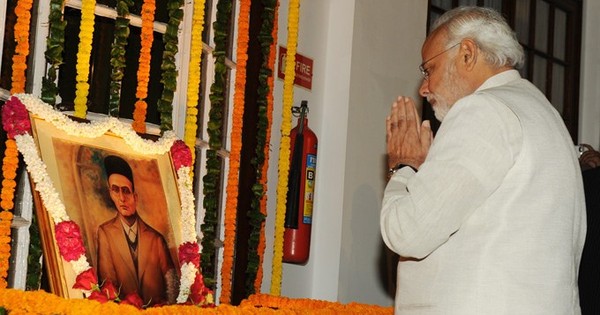Veer Savarkar’s book “Indian War of Independence – 1857” decisively shaped and gave direction to Bharat’s Revolutionary freedom movement. His other notable works include Six Glorious Epochs of Indian History, Hindu Pad-Padashahi and Gomantak.
“The nation that has no consciousness of its past has no future. Equally true it is that a nation must develop its capacity not only of claiming a past, but also of knowing how to use it for the furtherance of its future”
By Harish Kulkarni
This is exactly what we get after reading Savarkar. As a historian, Savarkar convincingly conveyed that our past is that of resistance, resurgence, and victory. This positive view of our history shows us the right path in shaping our future of being a strong, stable, and self-sufficient nation. While Savarkar’s writings were an inspiration to revolutionaries during the freedom movement, Post-independence they inspire in shaping national policies in Bharat’s interests.
Let’s explore in little detail Savarkar’s one such book on history.
The Indian War of Independence 1857
Veer Savarkar’s book “Indian War of Independence – 1857” decisively shaped and gave direction to Bharat’s Revolutionary freedom movement. It inspired the revolutionaries of Bharat to liberate the nation from the colonial British Raj and attain independence.
While most historians, British as well as Indian with colonial mindset, have described and dismissed the rising of 1857 as a ‘Sepoy Mutiny’, It was Veer Savarkar who wrote the story from Bharat’s perspective by calling it the Indian War of Independence. Thus Savarkar ensured thousands of patriots of 1857 got their due dignity.
One can confidently say that had there not been Savarkar’s book on 1857, even Netaji Bose’s INA would have been termed as muteness by colonial historians.
The book was so powerful that it literally shook the epicentre of the colonial British Raj. So much so that the special tribunal that tried Savarkar in 1910 for waging war against the king (of England of course) and sentenced him to Kalapani, quotes these words of Savarkar in its judgment
“The war begun on the 10th of May 1857 is not over on the 10th of May 1908. Nor can it ever till a 10th of May come sees the destiny accomplished and our Motherland stands free.”
Savarkar looked at the incidents of 1857 from a Bharatiya point of view. A champion revolutionary himself, he was amazed by the heroism, bravery, suffering and tragic fate of the leaders of 1857, and then decided to tell the story comprehensively with the help of all the material available to him at the time. He spent days and months at the India Office Library studying the 1857 times. The book originally written in Marathi, was translated into English by some Indian students staying in India House. Finally, this work was published in Holland in 1909, under the title “The Indian War of Independence –1857”.
Savarkar was a historian with a purpose. And the purpose was to inspire revolutionaries for an organised armed struggle against the colonial British Raj. And so the book did exactly that. The book became Bhagwad Gita for revolutionaries. It became a must-have with those already revolutionaries and a must-read for wannabe revolutionaries.
The level to which this book inspired the young revolutionaries can be imagined by how Jhansi Rani was described. While paying rich tributes to Jhansi Rani Lakshmibai, Savarkar writes
“Thus fought Rani Lakshmibai. She had achieved her purpose, fulfilled her ambition, carried out her resolve! One such life vindicates the whole existence of a nation! She was the concentrated essence of all virtues. A woman hardly in her twenties, beautiful as rose, charming in her manners, pure of conduct, she had the power of organising her subjects, exhibited by very few, even among men. The flame of patriotism was always burning in her heart. And she was proud of her country’s honour and pre-eminent in war! It is very rarely that a nation is so fortunate as to be able to claim such an angelic person, as a daughter and a queen. The honour has not yet fallen to the lot of England.”
The above description is a sample to gauge the book for its richness in vocabulary, epic storytelling style, and above all its quality to inspire youth for the cause of Bharat’s independence.
Interestingly the book was completely banned by British Raj, yet the book “Indian War of Independence 1857” saw multiple reprints in multiple languages, by multiple generations and groups of revolutionaries fighting for Bharat’s independence at different time periods. British police whenever raided any revolutionary group, one common thing the British found was Savarkar’s book in 1857. Such was the impact it had on revolutionaries. The book was published in multiple editions by Lala Hardayal, Madam Cama, Bhagat Singh, Netaji Bose’s INA etc. Thus Savarkar’s idea of using history to shape a nation’s future started working. And this particular book has had a significant role in the events that played a decisive role in delivering our Independence.
The book also brings out the master storyteller in Veer Savarkar. Right at the beginning itself the book makes it convincingly clear that the 1857 War was not for anybody’s personal gains, but to re-establish Swadharma and Swaraj in Bharat. Thus setting the context for the reader right at the start of a factually fantastic story. While portraying what were the driving principles of the 1857 war, Savarkar writes
These great principles were Swadharma and Swaraj. In the thundering roar rose to protect dharma, when there were evident signs of cunning, dangerous, and destructive attack on dharma dearer than life, and in the terrific blows dealt at the chain of slavery with the holy desire of acquiring Swaraj, when it was evident that chains of political slavery have been put round them and their God given liberty wrested away by subtle tricks – in these two lies the root principle of Revolutionary War.
The above principles were also the driving factors of future revolutionary movements to liberate Bharat from the clutches of the colonial British Raj.
The book on the Indian War of Independence 1857 meticulously and structurally walks us through the causes of the revolution, its planning, organising, execution, valour and bravery of people who fought the 1857 war, the setback, tragic suffering after the setback, still keeping the fire alive, that makes the book an epic of inspiration for future revolutions to come.
Most importantly, the book concludes that the underline cause for the setback was the treachery of the enemy. The conclusion gave the roadmap for future revolutions (NOT to be treacherous, but plan for the enemy’s treachery). And this exactly happened in the late 1940s (Joining the British Indian Army with a plan to get trained and switch over at an appropriate time is historically evidenced) when soldiers from British Indian Army started switching over to INA. And we all know of its decisive role in throwing out the colonial British Raj and gaining independence for Bharat.
Apart from being a champion revolutionary freedom fighter himself, Veer Savarkar is a revolutionary in many aspects like social reform, literature, poetry, political philosophy etc.
With an appeal to readers of this post to study more and more of Savarkar’s rich literary works, on his 140th birth anniversary (28th May 2023) this post pays respectful tributes to Veer Savarkar – The Historian.
This article first appeared in https://samvadaworld.com and it belongs to them.












